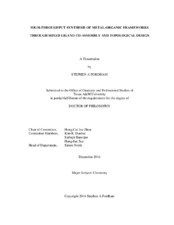| dc.description.abstract | The focus of this research is to investigate the synthesis of novel mixed linker metal-organic frameworks (MOFs) composed of pyrozolate and imidazolate based linkers through a mixed-ligand co-assembly process. In MOF synthesis, judicious selection of metal containing nodes combined with symmetric ligands can provide a modicum of predictability to the ultimate structure of the framework. Traditionally, carboxylate ligands have been heavily utilized for the construction of porous materials; however, nitrogen based ligands have not been as frequently used. Of the MOF family, zeolitic imidazolate frameworks (ZIFs) have been the most widely studied material composed of nitrogen-based ligands; however, these frameworks have primarily been constructed from only tetrahedral building units with zinc and cobalt metal nodes, which severely limits the diversity of such frameworks.
After an introduction of MOF materials and high throughput synthesis, we investigate the synthesis of new MOFs through mixed-linker co-assembly. An uncommon Pyrazole3Cu3OL3 building unit is observed in two new MOFs, PCN-351 and PCN-352. The first MOF, PCN-351 exhibits three distinct channels and small pores. PCN-352 is composed of molecular polyhedral cages and exhibits enhanced porosity and surface area. Additionally, high-throughput synthesis will allow for the systematic study of MOF formation under varying reaction conditions. Structural predictability is often limited, due to the many kinetic and thermodynamic factors that contribute to MOF formation including metal selection, ligand selection (connectivity, bonding angles, solubility, etc.), solvent selection, modulating agents, and pH values. This project will use a Chemspeed SLT-Swing robotic synthetic platform to exploit combinatorial chemistry methods in MOF synthesis. Utilizing the robotic platform, solvothermal reactions can be screened to optimize MOF formation through selection of solvent, determination of optimal reactant concentrations (metal to ligand ratios, modulation reagents, etc.), and determination of appropriate reaction temperature. This project builds upon the previously discover mixed-linker MOFs using ligand co-assembly. Ligand extension has often been used to study reticular chemistry for the formation of MOFs with enhanced porosity. Herein, we will explore the effect of linker length in the formation and symmetry of MOFs. A series of MOFs have been synthesized using the mixed linker co-assembly procedure and exhibit tuneable surface area and porosity.
Finally, we explore the use of porphyrin linkers in the synthesis of mesoporous MOFs (PCN-228, PCN-229 and PCN-230). Porphyrin linkers are highly conjugated systems that have been shown to eliminate interpenetration of MOFs. In this work a series of elongated porphyrin linkers with Zr6 metal nodes have been studied and show enhanced porosity and stability. We build upon the synthesis of porphyrin MOFs, using high-throughput synthesis and the mixed ligand co-assembly method, to construct a copper based porphyrin MOF isostructural to the reported zirconium MOFs.
In summary, several new mixed linker MOFs have been developed though a ligand co-assembly process and provide an interesting new direction for the development of materials with enhanced porosity through topological design. Additionally, high-throughput methods are a powerful tool for the synthesis of novel MOFs. | en |


